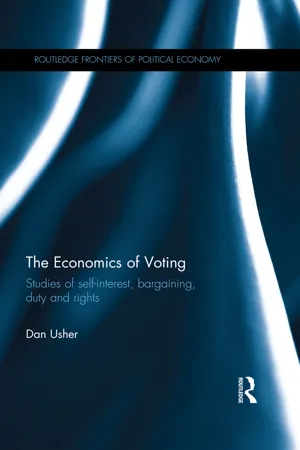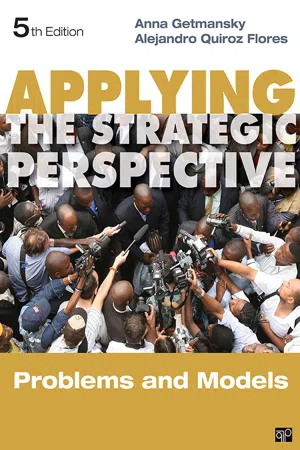Economics
Median Voter Theorem
The Median Voter Theorem states that in a majority-rule voting system, the outcome will reflect the preferences of the median voter. This is because politicians and parties will tend to adopt policies that appeal to the median voter in order to secure their support. As a result, the theorem suggests that in a two-party system, both parties will converge towards the center to attract the median voter.
Written by Perlego with AI-assistance
Related key terms
5 Key excerpts on "Median Voter Theorem"
- eBook - ePub
- Dan Usher(Author)
- 2015(Publication Date)
- Routledge(Publisher)
Suppose the election is between Abe and Beth where Abe is in fact the better candidate and where each voter has a 60 per cent chance of recognizing Abe as such. Voting in this context is like choosing a ball at random from an urn containing six balls marked Abe and four balls marked Beth. An electorate with only one voter would have a 60 per cent chance of electing Abe, an electorate with three voters would raise the probability to 64.8 per cent, an electorate with five voters would raise the probability to 68.3 per cent and a very large electorate would give Abe a sure majority of the votes. It is essential for this example that voters’ judgments be uncorrelated. At the opposite extreme where voters’ judgments are perfectly correlated, Abe’s chance of winning the election remains at 60 per cent regardless of the size of the electorate. Also, in sharp contrast to other circumstances to be discussed later on in this chapter, it might be beneficial to everybody for people to abstain when they are unsure about which candidate is best and when they believe that other voters are better informed.The line between the Median Voter Theorem and the Condorcet jury theorem is not as clear-cut as one might at first suppose. The guardian of the ballot box sees how many people voted for each candidate, but does not see why people voted as they did. Voting is partly a game played among voters with different objectives, partly a struggle to identify policies that are best for everybody, partly a conflict among politicians seeking office for its own sake and partly an attempt to elect the most competent5 and honest leaders. The most that can be expected of the theorems is that each, in its own way, sheds some light on the process. Other voting patterns identify other difficulties that must in practice be tolerated or overcome.Intensity of preference
The central proposition in economics is that, depending on initial conditions and subject to well-known qualifications, a competitive economy yields an efficient output of goods and assignment of goods to people, so that no planner, however wise, powerful or benevolent, could rearrange the economy to make everybody better off. A planner may favour some people at the expense of others, but cannot make everybody better off at once. By contrast, majority rule voting may be inefficient, recognizing only the numbers of people favouring each option in an election, but placing no weight on how deeply voters are concerned about the options they support. Sometimes this inefficiency is borne as a regrettable but necessary cost of democracy. Sometimes it is modified by the rules within which majority rule voting takes place. Sometimes it is avoided altogether by removing certain matters from the political arena. Several simple examples show what might be at stake. - eBook - ePub
Applying the Strategic Perspective
Problems and Models, Workbook
- Anna Getmansky, Alejandro Quiroz Flores(Authors)
- 2013(Publication Date)
- CQ Press(Publisher)
HAPTER 3TOOLS FOR ANALYZING INTERNATIONAL AFFAIRS
THE MEDIAN VOTER THEOREM
The Median Voter Theorem is a powerful tool to analyze social choice. The simple argument of this theorem is that in a group of voters arrayed along some continuous policy dimension, the median voter holds the critical position that will determine the outcome of decisions. That is, the position of the median voter will be the winning position.Three critical conditions must hold before we can use the Median Voter Theorem to predict outcomes. Actors must have (or be assumed to have) single-peaked preferences, we must have a unidimensional issue area, and decisions must be made by a majority rule.Exercise 3-1. The Power of the Median Votera) Why is the median voter in such a powerful position? Explain, either intuitively or using one or more numerical examples to demonstrate. b) Under what conditions does the Median Voter Theorem apply? In which cases can we not use the Median Voter Theorem to predict the winning position?Exercise 3-2. Unidimensionalitya) Provide an example of a unidimensional policy issue related to international relations. You can use recent topics mentioned in the news, or historical examples. What makes this policy unidimensional? What would make it not unidimensional? Display the issue graphically.b) Using the example from part a, provide examples of three players who have different positions with regard to this issue, and locate their ideal points in the unidimensional policy space above.Single-Peaked Preferences
The Median Voter Theorem assumes single-peaked preferences in spatial models. Briefly, an actor with single-peaked preferences - eBook - ePub
Game Theory in the Social Sciences
A Reader-friendly Guide
- Luca Lambertini(Author)
- 2011(Publication Date)
- Routledge(Publisher)
R = 1/2, all voters are in fact totally indifferent as to which party to patronize precisely because Left and Right have become identical in all respects. This entails two related consequences:• if xL = xR = 1/2, the median voter is not necessarily pivotal, while (or, because)• any voter is potentially pivotal. Shall we take the result of the Median Voter Theorem for granted, i.e., shall we buy it at its face value, or is there more to it? This delicate issue is the subject of the next section.6.3 The robustness of the Median Voter Theorem
As I have mentioned above, the linear segment may represent the set of all admissible policy stances a party or candidate may take, concerning the pension system, income taxation, etc. If this is the interpretation of the Hotelling–Downs model, then the first possible extension consists in allowing for more dimensions to jointly define a candidate's political platform. It can be shown that the basic result is robust to such a generalization (see Davis et al., 1972; Hinich et al., 1972, 1973; Slutsky, 1975; Austen-Smith, 1983; Calvert, 1985; Ansolabehere and Snyder, 2000), although in this case a pure-strategy equilibrium may not exist – the mixed-strategy equilibrium has been investigated by McKelvey and Ordeshook (1976) and Kramer (1978).If voters (or their preferences) are not uniformly (or even symmetrically) distributed along the segment, then there is no guarantee that the Median Voter Theorem may hold. The last 50 years of Italian politics constitute an evident illustration of the consequences of polarizing political preferences: while during the so-called First Republic - eBook - ePub
The Boy Who Could Change the World
The Writings of Aaron Swartz
- Aaron Swartz(Author)
- 2016(Publication Date)
- Verso(Publisher)
Despite that, turnout is treated with far less importance than persuasion in the average campaign. Part of this seems to be because of a widespread misconception among politicos about how persuadable people are. After all, the entire campaign seems to be a debate between competing ideologies—it’d be hard to understand why you’d go through all that effort if nobody ever changed their mind. Part of it seems to be a result of always seeing things in percentages. Part of it may be the result of the Median Voter Theorem.The Median Voter Theorem, a key result in rational choice politics, says that candidates both move to adopt the policy views of the median voter so as to get the maximum number of votes. If both candidates are right in the middle, with one just slightly to the left and one just slightly to the right, then they pick up the most votes—any move to an extreme would cede moderate voters to the remaining centrist.Even a cursory look at any recent campaign will make clear the Median Voter Theorem doesn’t hold in real life. It’s hard to even think of a federal election where the candidates were barely distinguishable. This could be because of persistent “irrationality” on the basis of voters and candidates, but it could also be because of turnout effects. If moving to the center causes people at the extremes not to show up, then it’s not as costless as the MVT would suggest.But there’s also a rational reason for not focusing on turnout: convincing people to turn out is hard. Under some analyses turning out an average voter is actually more expensive than persuading one, when it’d have to be half the price to be cost-effective. That’s because turning out a new voter increases your lead by just one vote, while persuading an existing voter increases it by two (one new vote for you and one vote less for your opponent). It takes a lot to get disaffected voters to the polls. By contrast, people who really like voting tend to do it every time no matter what’s going on.Those tend to be the people who vote in primaries, when turnout is especially low. As a result, even though there’s more room to increase your vote through turnout, turnout is even less of a factor. Even if the entire primary electorate considers themselves to be hard-left Democrats, you can fight a vicious campaign about who’s the real hard-left Democrat in the race and who’s the corporate shill. Because turnout is so low these battles are usually fought among very high-information voters, who follow the twists and turns of a complicated campaign. - eBook - ePub
Game Theory
A Nontechnical Introduction to the Analysis of Strategy
- Roger A McCain(Author)
- 2010(Publication Date)
- WSPC(Publisher)
median person in this vote. She prefers spending higher than Anna, so any movement toward her first preference, $200, from above will be supported also by Anna, and together they have a majority. She prefers spending less than Carole, so any movement toward $200, from below, will be supported also by Carole, and, again, together they have a majority. Taking both sides together, any movement toward Barbara's peak preference will have majority support. That is the advantage of being the median person.Table 20.2. Peak Preferences.Person Peak Preference Anna $150 Barbara $200 Carole $250 Terminology: Majority — Remember, a majority means more than half of the votes. If there are more than two alternatives, it may be that none of them gets a majority. In that case, the one that gets the most votes is said to have a plurality. These terms are sometimes confused in casual discussion, but in this textbook we use the term “majority” in its strict meaning — more than half.In general, the median person is the person who prefers a quantity higher than half-minus-one of the voters, and also lower than half-minus-one of the voters. Thus, any movement toward the median person's first preference from below will be supported by all the voters whose first preference is greater than hers; so, with her vote as well, it will be supported by a majority. Similarly, any movements toward the median person's peak preference from above will be supported by all of those whose first preference is less than hers, so with her vote (once again!) it will have majority support. In general, so long as all voters have single-peaked preferences, a move toward the median person's peak preference will be preferred by a majority of the voters. Thus the median person's preferences are decisive, under majority rule.This example illustrates some important aspects of the gametheoretic analysis of voting. First, votes can be thought of as strategies in a game, and majority rule (or some alternative voting scheme) defines the rules of the game. On the other hand, the sorority party example includes some important simplifying assumptions. The simplifying assumptions are that preferences are single-peaked and that the issues are laid out along a single dimension from less to more. We have also assumed that each member of the executive committee simply votes for the alternative she prefers. But that is not always the rational choice of strategies, as the next example shows.
Learn about this page
Index pages curate the most relevant extracts from our library of academic textbooks. They’ve been created using an in-house natural language model (NLM), each adding context and meaning to key research topics.




